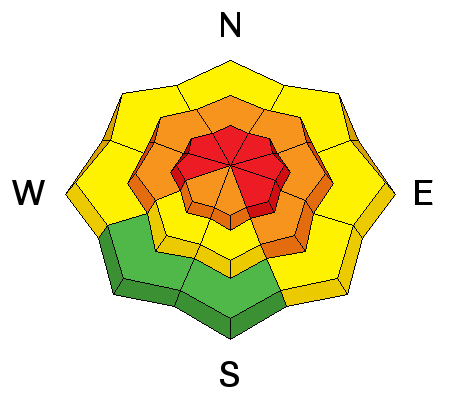| Please join us at the 23rd annual Black Diamond Fall Fundraiser Party Thursday Sept 15. Tickets are on sale now here, at the Black Diamond store & at REI. Special bonus raffle for online ticket purchasers! |  |

| Please join us at the 23rd annual Black Diamond Fall Fundraiser Party Thursday Sept 15. Tickets are on sale now here, at the Black Diamond store & at REI. Special bonus raffle for online ticket purchasers! |  |
| Advisory: Uintas Area Mountains | Issued by Craig Gordon for Wednesday - January 20, 2016 - 5:20am |
|---|
 |
current conditions The ridgetop winds are the big headline news today. Southerly winds increased late yesterday afternoon, peaking into the 60's around 7:00. They switched to the southwest and dialed it back a bit, but are pretty burly none-the-less... currently blowing 30-50 mph along the high ridges. Just an inch or two of snow fell overnight and temperatures are rather mild, hovering in the mid 20's. Recent winds are taking their toll on the snow surface and there's quite a bit of funk out there. However, wind sheltered terrain still offers cold, deep snow. Recent winds have had their way in open terrain, texturing the snow and forming drifts on the leeward side of mid and upper elevation ridges. Ted was near Double Hill yesterday and submitted a great report along with a video detailing his travels.... read here. Trip reports and observations are found here.
|
 |
recent activity
3'-5' deep and 200' wide, this slide was intentionally triggered Sunday on a steep, upper elevation, east facing slope by a very experienced backcountry rider. However, due to the tricky nature of the snowpack, the slide got a little out of hand as it broke wider and deeper than first anticipated. This slope avalanched to the ground during the Solstice storm and the snowpack structure prior to last weeks series of storms was weak and sugary. This is what we call a repeater. Yesterday, several close calls occurred on the Park City Ridgeline, near Powder Mountain, and in the Logan area mountains. Recent avalanche observations are found here. See or trigger an avalanche? Shooting cracks? Hear a collapse? It's simple. Go here to fill out an observation. |
| type | aspect/elevation | characteristics |
|---|


|


|

LIKELIHOOD
 LIKELY
UNLIKELY
SIZE
 LARGE
SMALL
TREND
 INCREASING DANGER
SAME
DECREASING DANGER
|
|
description
It'll be a day of rising avalanche danger and quite frankly, our snowpack is complex, there's a couple issues we're dealing with, and here's the story- Where the snowpack is deep, the avalanche concerns are pretty straight-forward and focus within the top layers of the snowpack. Last weeks light, fluffy storm snow is now capped with a strengthening slab and once triggered, today's avalanches can break a couple feet deep, failing on the new snow/old snow interface. Sounds easy enough.... right? Not so straight-forward and much trickier are avalanches that break to the ground. Slopes that avalanched big during the Solstice storm, left behind a weak, shallow snowpack and now we're stacking strong, cohesive snow on top. It's a lot like an early season snowpack and with additional snow, water, and wind, we're starting to get to the tipping point. Many steep mid and upper elevation slopes facing the north half of the compass just need a trigger like us to come along and knock the legs out from under the slab. In either case, the snowpack will feel strong, relatively stable, and good to go under our skis, board, or sled. But as we know, strong snow on weaker snow is a scary combination in our mountains. We're dealing with what we call a peristent slab and it often tricks even very experienced people. As a matter of fact, since Sunday, we've had multiple close calls each day, with several people caught off guard as avalanches broke above them while they were well out on the slope. So with all this complexity how do we ride safely? It's actually pretty basic... simply steer clear of steep wind drifted slopes, especially terrain that faces the north half of the compass. Slopes that avalanched to the ground during the Solstice Storm are thin and weak and remain guilty until proven otherwise.
Big differance is snowpack depth and strength- Where the snowpack is deep, shears breaking to weak snow near the ground are getting ragged and lack energy, suggesting a turn towards stronger snow.
|
 |
weather Snow develops this morning and it should be stomping in the next couple hours with 3"-6" of snow rapidly accumulating. Winds switch to the west and northwest and will be cranking in the 40's and 50's with gusts in the 70's along the high ridges. Temperatures don't vary much from where we're at this morning. Storm totals should be close to a foot by Thursday morning. High pressure builds for Thursday/Friday with another storm slated for the weekend.
|
| general announcements Remember your information can save lives. If you see anything we should know about, please participate in the creation of our own community avalanche advisory by submitting snow and avalanche conditions. You can call me directly at 801-231-2170, email [email protected], or email by clicking HERE This is a great time of year to schedule a free avalanche awareness presentation for your group or club. You can contact me at 801-231-2170 or email [email protected]. To register for the first in our series of on-the-snow sled specific classes you can register here. The information in this advisory is from the US Forest Service which is solely responsible for its content. This advisory describes general avalanche conditions and local variations always occur. The information in this advisory expires 24 hours after the date and time posted, but be will be updated by 7:00 AM on Thursday, January 21st.
|
Advisory Hotline: (888) 999-4019 | Contact Information